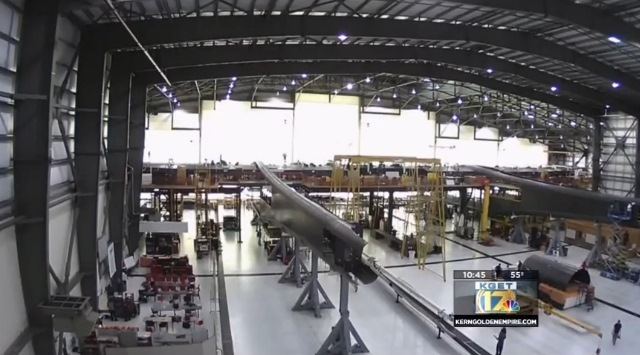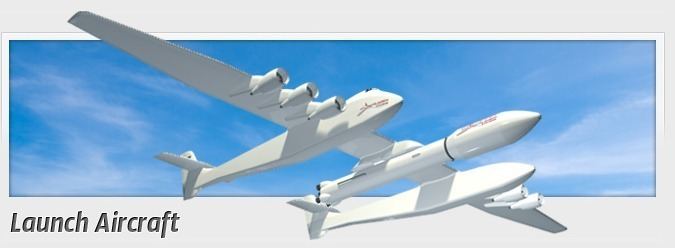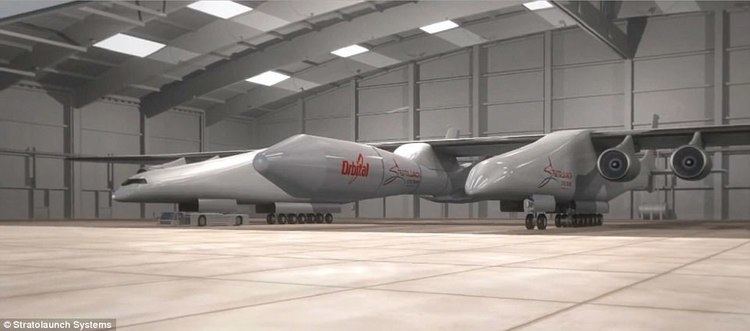Length 73 m | Manufacturer Scaled Composites | |
 | ||
The Scaled Composites Model 351 (nicknamed the "Roc") is being built for Stratolaunch Systems to provide a platform from which air-launch space missions can be staged. With a wingspan of 117 m (385 ft), the design has the longest wingspan of any airplane to date (July 2015).
Contents

In August 2015, Scaled Composites president Kevin Mickey stated the company has so far assembled "roughly 200,000 pounds of composite structure" for the vehicle and if put on an American football field, "its wingtips would extend beyond the goalposts by 15 feet on each side."

Each of the twin fuselages of the aircraft is 238 feet (72 metres) long and will be supported by 12 main landing gear wheels and two nose gear wheels, for a total of 28 wheels. It will require 12,000 feet of runway to lift-off.

The air-launch altitude is planned for about 35,000 feet, according to Chuck Beams of Vulcan Aerospace, a company owned by Paul Allen which oversees the project. As of June 2016, the project is 76% complete. Payload is noted as in excess of 500,000 pounds.

As of November 2015, the rocket or payload for the mega aircraft has not been publicly announced, after two previous plans—SpaceX Falcon 9 Air and Orbital ATK Pegasus II rocket design concepts—had been shelved.
As of October 2016 "Orbital ATK will supply multiple Pegasus XL rockets for Stratolaunch to mount underneath the company’s huge carrier aircraft currently under construction in Mojave, California" (see ref #20, below).
History
The project was started nearly a year prior to the December 2011 public announcement. Dynetics began work in early 2011, and had approximately 40 employees working on the project at the time of the announcement, as of December 2011. SpaceX efforts began only shortly prior to the public announcement.
In January 2012, Stratolaunch CEO Gary Wentz made it explicit that Stratolaunch would name the carrier aircraft only later. The "mothership is currently known only by its Scaled model number: M351."
Construction progress on the giant hangar being built in Mojave, California for the Stratolaunch Carrier Aircraft was given in an October 2012 story at Parabolic Arc. The first of two manufacturing buildings, the "88,000 square foot facility [to] be used to construct the composite sections of the wing and fuselage sections" was opened for production in October 2012, two months ahead of schedule and on budget.
In October 2013, the first flight of the carrier aircraft was expected in 2016, with the first flight of the air-launched rocket in 2018.
As of April 2015, the aircraft was 40% complete, with fabrication of parts at 80%. In November 2015, Stratolaunch CEO Gary Wentz "stepped down as president and CEO of Stratolaunch Systems to join United Launch Alliance to lead human launch services" for ULA. Vulcan Aerospace ended its contract with Orbital ATK in mid-2015 and indicated that a decision on a new rocket for the Stratolaunch Carrier Aircraft would be made in late 2015.
In June 2016, the initial aircraft is nearing completion, with Scaled Composites having 300 people working on the project. Only a few composite parts have yet to be made, assembled, and installed on the aircraft body. Overall assembly is 76% complete.
Design
The Model 351 has a structural similarity to the Scaled Composites White Knight Two. It features two main fuselage sections joined with a common wing with a centrally mounted Mating and Integration System (MIS) capable of handling a 230,000 kg (500,000 lb) load and being developed by Dynetics. Each fuselage has its own horizontal and vertical stabilizer. Three engines are positioned on pylons outboard of each fuselage. The cockpit is positioned within the starboard fuselage.
The aircraft will be powered by six 56,000 lbf (250 kN) Pratt & Whitney PW4056 engines that were obtained from "two used 747-400s that will be cannibalized for engines, avionics, flight deck, landing gear and other proven systems that can be recycled to cut development costs." As of April 2012, two former United Airlines Boeing 747-400 aircraft (Serial numbers 28715 & 28716) have been acquired and are currently stored at the Mojave Air & Space Port.
The primary launch cargo was originally slated be a multistage booster developed by SpaceX. However in December 2012 Stratolaunch announced that they had amicably parted company with SpaceX due to the design evolving away from a good fit with SpaceX's long-term business model. In late 2012 and early 2013, Stratolaunch worked with Orbital Sciences Corporation to develop an alternative rocket conceptual design. By May 2013, Orbital was under contract to develop the Pegasus II for Stratolaunch, with a payload of 6,100 kg (13,500 pounds).
The Orbital contract work was ended in mid-2015, and Stratolaunch has not publicly announced a new plan for the rocket or payload for the large aircraft as of November 2015.
As of October 2016 "Orbital ATK will supply multiple Pegasus XL rockets for Stratolaunch to mount underneath the company’s huge carrier aircraft currently under construction in Mojave, California."
World's longest wingspan
Allen and aircraft initial concept designer Burt Rutan stated that the carrier aircraft would have a wingspan of 117 m (385 ft), This would make it the largest airplane, by wingspan, to ever fly.
Specifications (Stratolaunch Systems Carrier)
Data from
General characteristics
